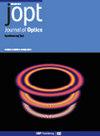Optical microscope with nanometer longitudinal resolution based on a Linnik interferometer
IF 2.7
4区 物理与天体物理
Q3 OPTICS
引用次数: 0
Abstract
A widefield microscope based on a Linnik interferometer was designed, constructed, and tested. The phase-shifting and polarized single-shot methods were used to measure interference patterns. Both methods use a low-coherence light-emitting diode as the light source, achieving a resolution of 10 nm in the Z direction and diffraction-limited resolution in the X and Y directions. The single-shot method is vibration-insensitive, allowing for the observation of moving objects. The simplicity and low cost of this instrument make it valuable for a wide range of applications.基于 Linnik 干涉仪的纳米级纵向分辨率光学显微镜
设计、制造并测试了基于林尼克干涉仪的宽场显微镜。采用移相法和偏振单光法测量干涉图案。这两种方法都使用低相干性发光二极管作为光源,Z 方向的分辨率达到 10 纳米,X 和 Y 方向的分辨率达到衍射极限。单次拍摄法对振动不敏感,因此可以观测移动物体。该仪器操作简单、成本低廉,因此具有广泛的应用价值。
本文章由计算机程序翻译,如有差异,请以英文原文为准。
求助全文
约1分钟内获得全文
求助全文
来源期刊

Journal of Optics
OPTICS-
CiteScore
4.50
自引率
4.80%
发文量
237
审稿时长
1.9 months
期刊介绍:
Journal of Optics publishes new experimental and theoretical research across all areas of pure and applied optics, both modern and classical. Research areas are categorised as:
Nanophotonics and plasmonics
Metamaterials and structured photonic materials
Quantum photonics
Biophotonics
Light-matter interactions
Nonlinear and ultrafast optics
Propagation, diffraction and scattering
Optical communication
Integrated optics
Photovoltaics and energy harvesting
We discourage incremental advances, purely numerical simulations without any validation, or research without a strong optics advance, e.g. computer algorithms applied to optical and imaging processes, equipment designs or material fabrication.
 求助内容:
求助内容: 应助结果提醒方式:
应助结果提醒方式:


